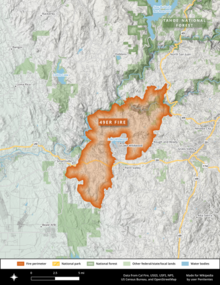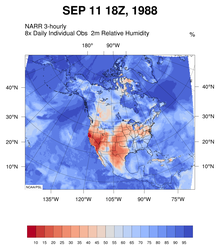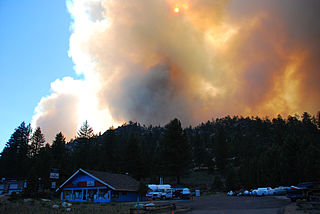
The Angora Fire was a 2007 wind-driven wildfire in El Dorado County, California. It started near North Upper Truckee Road subdivision near Angora Lakes, Fallen Leaf Lake, Echo Lake and South Lake Tahoe, California around 2:15 PM on Sunday, June 24, 2007, as a result of an illegal campfire. As of July 2, 2007, the fire was 100% contained, and 100% control was achieved on July 10. The fire burned 3,100 acres (12.5 km2), destroyed 242 residences and 67 commercial structures, and damaged 35 other homes. At the peak of the fire, there were as many as 2,180 firefighters involved in battling the blaze. The fire cost $13.5 million to fight and caused at least $150 million in property damage.

The 2007 Moonlight Fire was a large wildfire that burned near Westwood in Lassen County, California. The fire, which started on September 3, scorched 64,997 acres before being declared contained on September 19. Approximately 2,300 firefighters were involved in fighting the fire. Strong winds pushed smoke to the Sacramento Valley, Bay Area, Nevada and Idaho. In Plumas County, 500 homes were threatened by the Moonlight Fire; 100 residences were evacuated near Greenville in the North Arm area of Indian Valley, as the wild fire was still raging in the Plumas National Forest.
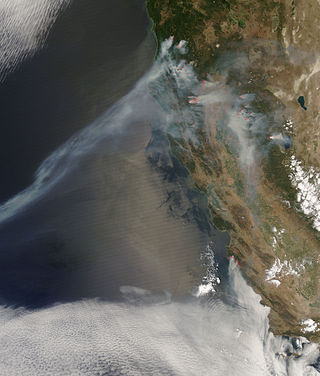
The 2008 California wildfire season was one of the most devastating in the state of the 21st century. While 6,255 fires occurred, about two-thirds as many as in 2007, the total area burned— 1,593,690 acres —far exceeded that of previous years.

The 2014 King Fire was a large wildfire in El Dorado County, California, which burned 97,717 acres primarily in the Eldorado National Forest. The wildfire started on September 13, 2014, near Pollock Pines, California, to the east of Sacramento. The ensuing fire suppression effort, which cost more than $100 million and engaged more than 8,000 personnel at its peak, allowed for the full containment of the King Fire by October 9, 2014. Despite the size and ferocity of the fire, it caused no deaths. Eighty structures were destroyed, the majority of them outbuildings. The King Fire was determined to have been caused by an act of arson and a suspect was swiftly apprehended and convicted in 2016.

The 2015 California wildfire season was a series of wildfires that burned across the state of California. By the end of 2015 a total of 8,745 fires were recorded, burning 893,362 acres (3,615 km2) across the state. Approximately 3,159 structures were damaged or destroyed by wildfires, and at least 7 fatalities were recorded.

The October 2017 Northern California wildfires, also known as the Northern California firestorm, North Bay Fires, and the Wine Country Fires were a series of 250 wildfires that started burning across the state of California, United States, beginning in early October. Twenty-one became major fires that burned at least 245,000 acres (99,148 ha).

The 2018 wildfire season was the deadliest and most destructive wildfire season in California history. It was also the largest on record at the time, now third after the 2020 and 2021 California wildfire seasons. In 2018, there were a total of 103 confirmed fatalities, 24,226 structures damaged or destroyed, and 8,527 fires burning 1,975,086 acres (799,289 ha), about 2% of the state's 100 million acres of land. Through the end of August 2018, Cal Fire alone spent $432 million on operations. The catastrophic Camp Fire alone killed at least 85 people, destroyed 18,804 buildings and caused $16.5 billion in property damage, while overall the fires resulted in at least $26.347 billion in property damage and firefighting costs, including $25.4 billion in property damage and $947 million in fire suppression costs.

The 2020 California wildfire season, part of the 2020 Western United States wildfire season, was a record-setting year of wildfires in California. By the end of the year, 9,917 fires had burned 4,397,809 acres (1,779,730 ha), more than 4% of the state's roughly 100 million acres of land, making 2020 the largest wildfire season recorded in California's modern history, though roughly equivalent to the pre-1800 levels which averaged around 4.4 million acres yearly and up to 12 million in peak years. California's August Complex fire has been described as the first "gigafire", burning over 1 million acres across seven counties, an area larger than the state of Rhode Island. The fires destroyed over 10,000 structures and cost over $12.079 billion in damages, including over $10 billion in property damage and $2.079 billion in fire suppression costs. The intensity of the fire season has been attributed to a combination of more than a century of poor forest management and higher temperatures resulting from climate change.

The 2020 Creek Fire was a very large wildfire in central California's Sierra National Forest, in Fresno and Madera counties. One of the most significant fires of California's record-setting 2020 wildfire season, it began on September 4, 2020, and burned 379,895 acres (153,738 ha) over several months until it was declared 100% contained on December 24, 2020. The Creek Fire is the fifth-largest wildfire in recorded California history and the second-largest single fire—i.e. not part of a larger wildfire complex—following the 2021 Dixie Fire.

The North Complex Fire was a massive wildfire complex that burned in the Plumas National Forest in Northern California in the counties of Plumas and Butte. 21 fires were started by lightning on August 17, 2020; by September 5, all the individual fires had been put out with the exception of the Claremont and Bear Fires, which merged on that date, and the Sheep Fire, which was then designated a separate incident. On September 8, strong winds caused the Bear/Claremont Fire to explode in size, rapidly spreading to the southwest. On September 8, 2020, the towns of Berry Creek and Feather Falls were immediately evacuated at 3:15 p.m. PDT with no prior warning, By September 9, 2020, the towns of Berry Creek and Feather Falls had been leveled, with few homes left standing. The fire threatened the city of Oroville, before its westward spread was stopped. The fire killed 16 people and injured more than 100. Among the 16 fatalities was a 16-year-old boy. The complex burned an estimated 318,935 acres (129,068 ha), and was 100% contained on December 3. The fire was managed by the U.S. Forest Service in conjunction with Cal Fire, with the primary incident base in Quincy. The North Complex Fire was the sixth-largest in California's modern history, and the deadliest fire in the 2020 California wildfire season.

The River Fire was a destructive 2021 wildfire that burned 2,619 acres (1,060 ha) near Colfax in Nevada County and Placer County, California. The fire broke out on August 4, 2021, and burned 2,619 acres (1,060 ha) before it was fully contained on August 13, 2021. The River Fire destroyed 142 structures, damaged 21 more, and resulted in four injuries to firefighters and civilians. It was the fifth most destructive fire of California's 2021 wildfire season. The exact cause of the fire is unknown, but it was determined to have been of human origin by investigators who traced the ignition to a campground by the Bear River west of Colfax.

The 2022 California wildfire season was a series of wildfires throughout the U.S. state of California. By the end of the year, a total of 7,667 fires had been recorded, totaling approximately 363,939 acres across the state. Wildfires killed nine people in California in 2022, destroyed 772 structures, and damaged another 104. The 2022 season followed the 2020 and 2021 California wildfire seasons, which had the highest and second-highest (respectively) numbers of acres burned in the historical record, with a sharp drop in acreage burned.

The Mosquito Fire was California's largest wildfire of 2022, burning in the American River watershed in Placer and El Dorado counties in Northern California. The fire began on September 6 amid a state-wide heat wave and went on to burn 76,788 acres, primarily in the Tahoe and Eldorado National Forests, while also destroying 78 structures in the rural communities of Michigan Bluff, Foresthill, and Volcanoville. Authorities declared the fire fully contained on October 22 following several storms. The fire suppression effort cost more than $180 million, and at its peak involved more than 3,700 firefighters. The precise cause of the fire is not known, but the potential role of Pacific Gas & Electric Company (PG&E) equipment is the subject of multiple civil lawsuits and a Forest Service investigation. The Mosquito Fire was one of 7,477 total wildfires in California in 2022, which burned a combined 331,358 acres (134,096 ha).

The 1992 Fountain Fire was a large and destructive wildfire in Shasta County, California. After igniting on August 20 in an act of probable but unattributed arson, the fire was driven by strong winds, outpacing firefighters for two days while exhibiting extreme fire behavior such as long-range spotting, crown fire runs, and pyrocumulonimbus clouds that generated dry lightning. The fire consumed 63,960 acres (25,880 ha) and destroyed hundreds of homes, primarily in the communities of Round Mountain and Montgomery Creek along the State Route 299 corridor. In 1992, the Fountain Fire was the third most destructive wildfire in California's recorded history, though it no longer features among the top 20 most destructive California wildfires. At a suppression cost of more than $22 million, it was then the most expensive fire to contain, but has since been surpassed in that respect.

The Kinneloa Fire was a destructive wildfire in October 1993 in Los Angeles County, California. The fire burned 196 structures in the San Gabriel Mountains foothill communities of Altadena, Kinneloa Mesa, and Sierra Madre, becoming the 12th most destructive wildfire in recorded California history at the time and to this day one of the most destructive wildfires in Los Angeles County history. The fire resulted in one fatality and a multitude of minor injuries: one person died of pneumonia complicated by smoke inhalation, and two indirect deaths resulted from debris flows in the burn area more than four months later.

The 2001 California wildfire season was a series of wildfires that burned throughout the U.S. state of California during 2001. According to California Department of Forestry and Fire Protection statistics, 9,317 fires burned a total of 377,340 acres.

The 2000 California wildfire season was a series of wildfires that burned throughout the U.S. state of California during 2000. According to California Department of Forestry and Fire Protection statistics, 7,622 fires burned a total of 295,026 acres. Cal Fire wildfire suppression costs for fires that burned within the agency's jurisdiction amounted to $109 million. Damages for the same amounted to $87.3 million, with a total of 389 structures lost. The largest wildfires of the year in California were the Manter and Storrie fires, which burned 74,000 and 55,000 acres in Tulare and Plumas counties respectively.

The Storrie Fire was a sizeable wildfire in Northern California's Plumas County and the second-largest of California's 2000 wildfire season. The fire began on August 17, 2000, and was fully contained by September 9; it burned 55,261 acres in total and resulted in minimal property damage or casualties. The cost of containing the Storrie Fire amounted to $22 million.
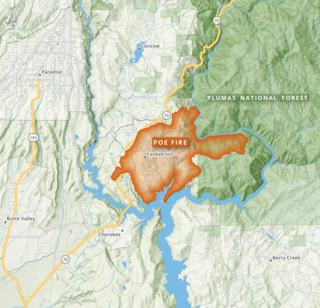
The 2001 Poe Fire was a destructive wildfire in the U.S. state of California's Butte County. After igniting on September 6, the fire burned 8,333 acres and destroyed at least 133 structures in the Big Bend and Yankee Hill areas north of Oroville before it was fully contained on September 12, 2001. The fire was the most destructive incident of California's 2001 wildfire season.

The Copper Fire was a wildfire in Los Angeles County, Southern California, in June of 2002. After igniting on June 5 near the city of Santa Clarita, the fire burned for a week and consumed 23,407 acres, damaging wildlife habitat and historic structures in the Angeles National Forest before it was fully contained on June 12. The fire destroyed more than two dozen buildings and resulted in at least eight firefighter injuries. The government eventually sued two contractors whose equipment and negligence it argued had sparked the fire during construction work, resulting in a jury award in its favor of over $36 million.

